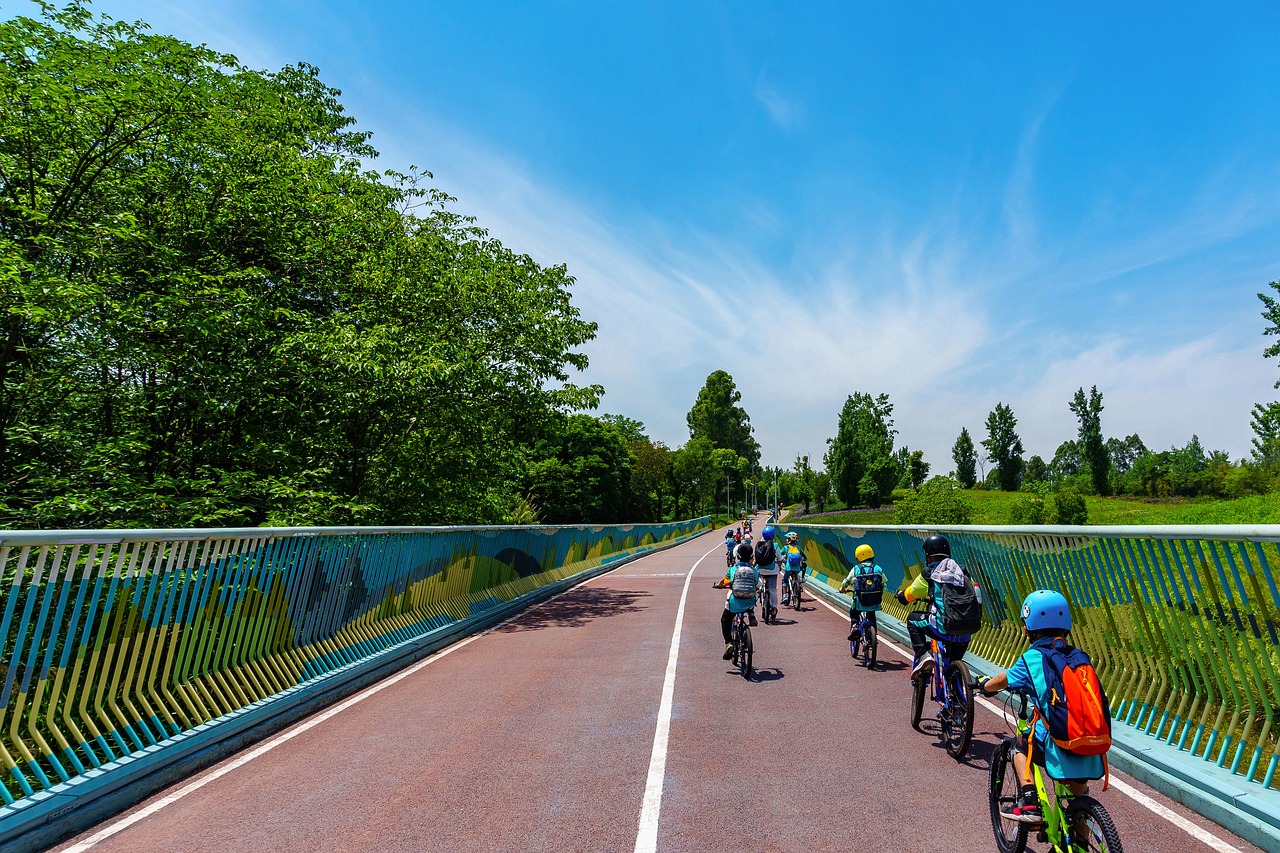The Impact of Bike Lanes on Urban Sustainability
In today's fast-paced urban environments, the quest for sustainability has become more critical than ever. One innovative solution gaining traction is the implementation of bike lanes. These dedicated paths for cyclists not only provide a safe space for biking but also contribute significantly to the overall sustainability of our cities. Imagine a city where the air is cleaner, traffic is less congested, and residents are healthier—all thanks to the simple act of cycling. This article explores how bike lanes are transforming urban landscapes, promoting a greener future, and enhancing the quality of life for city dwellers.
Bike lanes offer numerous advantages that extend beyond just providing a safe route for cyclists. Firstly, they play a crucial role in reducing traffic congestion. When more people choose to cycle rather than drive, the number of vehicles on the road decreases, leading to smoother traffic flow. This not only saves time for commuters but also reduces the stress associated with gridlock. Furthermore, the reduced reliance on cars translates to improved air quality. Fewer cars on the road mean fewer emissions, which is a win for both the environment and public health.
Moreover, cycling is an excellent form of exercise, promoting a healthier lifestyle. Cities that invest in bike lanes often see a rise in physical activity among residents, which can lead to lower healthcare costs and a more vibrant community. In essence, bike lanes are not just paths for bicycles; they are pathways to a healthier, more sustainable urban environment.
Despite the myriad benefits, the implementation of bike lanes is not without its challenges. One significant hurdle is funding. Many cities struggle to allocate the necessary budget for building and maintaining cycling infrastructure. Additionally, there can be considerable community resistance to bike lane projects, particularly from drivers who fear losing road space or from businesses concerned about potential disruptions. Space constraints in densely populated urban areas can also complicate the planning process, making it difficult to find suitable locations for bike lanes.
Engaging the community in the planning process is vital for the acceptance of bike lanes. When residents are involved, they are more likely to support initiatives that align with their needs and concerns. Effective communication can help alleviate fears and highlight the advantages of cycling infrastructure. For example, city planners can organize town hall meetings or workshops to discuss bike lane designs and gather feedback from the community.
Public awareness campaigns are essential in educating residents about the benefits of bike lanes. These campaigns can promote a culture of cycling by showcasing success stories from other cities, sharing information about health benefits, and emphasizing the environmental impact of choosing a bike over a car. By fostering a positive perception of cycling, cities can encourage more people to embrace this sustainable mode of transportation.
Establishing feedback mechanisms allows residents to voice their opinions and suggestions regarding bike lane design and placement. This collaborative approach to urban development not only helps in creating bike lanes that meet the community's needs but also fosters a sense of ownership among residents. When people feel heard, they are more likely to support and utilize the bike lanes.
Bike lanes significantly contribute to reducing carbon emissions and improving urban air quality. By promoting cycling over driving, cities can make substantial strides towards achieving their sustainability goals. For instance, studies have shown that cities with extensive bike lane networks experience lower levels of air pollution and a decrease in greenhouse gas emissions. This not only benefits the environment but also enhances the quality of life for residents, making cities more livable.
The economic impact of bike lanes is another compelling reason for their implementation. Increased local business revenues often accompany the establishment of bike lanes, as cyclists are more likely to stop and shop at nearby stores. Additionally, the reduction in healthcare costs due to healthier populations can lead to significant savings for cities and communities. Investing in cycling infrastructure can yield long-term financial benefits that far outweigh the initial costs.
Conducting a cost-benefit analysis is essential to determine the financial viability of bike lane projects. This analysis weighs the initial investment against potential savings and economic growth. For instance, cities may find that the long-term benefits of reduced traffic congestion, improved public health, and increased local business revenues outweigh the upfront costs of building bike lanes.
Identifying diverse funding sources is crucial for the successful development and maintenance of bike lane infrastructure. Government grants, private partnerships, and community fundraising initiatives can all play a role in financing these projects. By exploring various funding avenues, cities can ensure the sustainability of their bike lane networks and continue to promote cycling as a viable transportation option.
- What are bike lanes? Bike lanes are designated paths on roads specifically for cyclists, aimed at providing a safe and efficient route for biking.
- How do bike lanes improve air quality? By encouraging more people to cycle instead of drive, bike lanes help reduce vehicle emissions, leading to cleaner air.
- What challenges do cities face when implementing bike lanes? Common challenges include funding issues, community resistance, and limited space in urban areas.
- How can communities support bike lane initiatives? Communities can engage in discussions, provide feedback, and participate in public awareness campaigns to advocate for bike lanes.

Benefits of Bike Lanes
Bike lanes are more than just painted lines on the road; they are a vital component of a thriving, sustainable urban environment. One of the most significant benefits of bike lanes is their ability to reduce traffic congestion. When more people choose to cycle instead of driving, the number of vehicles on the road decreases, leading to smoother traffic flow. Imagine a city where you can actually get from point A to point B without sitting in endless traffic jams. Sounds appealing, right?
Moreover, bike lanes contribute to improved air quality. Vehicles are notorious for emitting pollutants that contribute to smog and respiratory issues. By encouraging cycling, cities can drastically cut down on these emissions. In fact, studies have shown that cities with extensive bike lane networks often experience significantly lower levels of air pollution. This not only benefits the environment but also promotes better health for residents, leading to fewer health-related issues and lower healthcare costs.
Speaking of health, let’s talk about public health benefits. Cycling is an excellent form of exercise, and bike lanes make it safer and more accessible for everyone. When people feel secure riding their bikes, they’re more likely to incorporate cycling into their daily routines. This increase in physical activity can help combat obesity and other lifestyle-related diseases. It’s like hitting two birds with one stone: you improve your health while also doing your part for the planet.
Additionally, bike lanes can enhance the overall quality of urban life. Cities with bike-friendly infrastructure often see an increase in community engagement and social interaction. Cyclists are more likely to stop and shop at local businesses, which can boost the economy. Plus, bike lanes can beautify neighborhoods, making them more inviting and enjoyable for residents and visitors alike. Imagine riding through a vibrant community filled with shops, parks, and friendly faces—sounds like a dream, doesn’t it?
To sum it up, the benefits of bike lanes are multifaceted. They not only reduce traffic congestion and improve air quality but also promote public health and enhance urban life. Investing in bike lanes is like planting a seed for a better future—one where cities are cleaner, healthier, and more vibrant places to live.
- What are bike lanes? Bike lanes are designated paths or lanes on the road specifically for cyclists, aimed at providing a safe and efficient way to ride.
- How do bike lanes affect traffic congestion? By providing a safe space for cyclists, bike lanes encourage more people to bike instead of drive, which can significantly reduce the number of cars on the road.
- Are there health benefits to cycling? Yes, cycling is a great form of exercise that can help improve cardiovascular health, strengthen muscles, and promote overall well-being.
- How do bike lanes impact local businesses? Bike lanes can increase foot traffic in local areas, as cyclists are more likely to stop and shop at nearby businesses.

Challenges in Implementation
Implementing bike lanes in urban areas is not as straightforward as one might think. While the benefits are clear, the road to establishing these lanes can be fraught with various challenges. One of the most significant hurdles is funding. Cities often operate under tight budgets, and allocating funds for bike lanes can be a tough sell compared to other pressing needs like road maintenance or public transportation. This financial challenge can lead to delays or even cancellations of planned bike lane projects.
Another major issue is community resistance. Many residents may feel that bike lanes take away valuable road space or parking spots, leading to pushback against their implementation. This resistance is often fueled by a lack of understanding of the benefits that bike lanes can bring. When people see a bike lane being constructed, they might think it’s just a loss of space for cars, not realizing that it can lead to reduced traffic congestion and a more vibrant community overall.
In addition to funding and community concerns, there are also space constraints to consider. Urban environments are often densely populated, leaving little room for new infrastructure. Cities must find creative solutions to incorporate bike lanes without disrupting existing traffic flow or pedestrian pathways. This might involve narrowing lanes, which can be controversial among drivers, or reallocating space from parking, which can upset local businesses.
To successfully navigate these challenges, cities need to engage in effective communication with their communities. By explaining the long-term benefits of bike lanes—such as improved air quality, reduced traffic, and enhanced public health—local governments can alleviate concerns and foster a more supportive environment. Initiatives like public forums or surveys can help gather feedback and build a sense of ownership among residents.
Engaging the community in the planning process is vital for the acceptance of bike lanes. When residents feel involved, they are more likely to support the project, understanding that it serves their interests. This engagement can take various forms, such as workshops, public meetings, and online forums where people can express their opinions and ask questions. The key is to create an open dialogue that allows for the community's voice to be heard.
Public awareness campaigns can educate residents about the benefits of bike lanes, promoting a culture of cycling and encouraging more people to embrace this sustainable mode of transportation. These campaigns can utilize various media, including social media, local newspapers, and community events, to spread the word. By highlighting success stories from other cities and showcasing how bike lanes can improve quality of life, cities can shift public perception and increase support.
Establishing feedback mechanisms allows residents to voice their opinions and suggestions regarding bike lane design and placement, fostering a collaborative approach to urban development. This could involve creating an online platform where citizens can submit their ideas or concerns, ensuring that the implementation of bike lanes reflects the community's needs and preferences.
Ultimately, while the challenges in implementing bike lanes may seem daunting, they are not insurmountable. With the right strategies, community engagement, and a commitment to sustainability, cities can overcome these obstacles and pave the way for a healthier, more environmentally friendly future.
Q: What are the main benefits of bike lanes?
A: Bike lanes help reduce traffic congestion, improve air quality, and promote public health by encouraging more people to cycle instead of drive.
Q: How can communities support bike lane initiatives?
A: Communities can support bike lane initiatives by participating in planning meetings, providing feedback, and advocating for cycling infrastructure through public awareness campaigns.
Q: What are some common challenges faced when implementing bike lanes?
A: Common challenges include funding issues, community resistance, and space constraints within urban environments.
Q: How can cities fund bike lane projects?
A: Cities can explore various funding sources, including government grants, private partnerships, and community fundraising efforts.

Community Engagement
When it comes to the successful implementation of bike lanes, is not just a nice-to-have; it’s a must-have. Imagine trying to build a house without consulting the people who live in it. Sounds chaotic, right? The same principle applies to urban planning. Engaging the community in the planning process fosters a sense of ownership and acceptance, making residents more likely to embrace the changes. So, how can we make this happen?
First off, it’s crucial to establish open lines of communication. This means organizing community meetings where residents can voice their opinions and share their concerns regarding the proposed bike lanes. By facilitating discussions, planners can address misconceptions and highlight the benefits of cycling infrastructure, such as reduced traffic congestion and improved public health. It’s all about creating a dialogue rather than a monologue!
Another effective way to engage the community is through interactive workshops. These workshops can be designed to gather input on bike lane designs, placements, and safety features. When residents feel that their voices are being heard and that they have an active role in shaping their environment, they are more likely to support the initiative. Think of it as a collaborative art project—everyone contributes their ideas, and together, they create something beautiful and functional.
Additionally, leveraging digital platforms can enhance community engagement. Social media campaigns, online surveys, and dedicated websites can reach a broader audience, making it easier for people to participate in discussions about bike lanes. This digital approach is especially important in our fast-paced world, where people often prefer to engage from the comfort of their homes.
To sum it up, community engagement is the cornerstone of successful bike lane implementation. It transforms potential resistance into enthusiastic support, paving the way for a more sustainable urban environment. By involving residents in the planning process, cities can ensure that bike lanes are not only beneficial but also embraced by the very people they are designed to serve.
- Why are bike lanes important for urban areas?
Bike lanes promote cycling as a safe and viable transportation option, reducing traffic congestion and improving air quality. - How can communities get involved in bike lane planning?
Communities can participate through public meetings, workshops, and online surveys to share their opinions and suggestions. - What are the environmental benefits of bike lanes?
Bike lanes help reduce carbon emissions by encouraging more people to cycle instead of driving, leading to improved urban air quality. - How do bike lanes impact local economies?
Investing in bike lanes can increase foot traffic, benefiting local businesses and reducing healthcare costs associated with poor public health.

Public Awareness Campaigns
Public awareness campaigns play a crucial role in the successful implementation of bike lanes within urban environments. Imagine walking through your city and seeing vibrant posters, engaging social media posts, and lively community events all centered around the benefits of cycling. These campaigns are not just about informing the public; they are about creating a culture of cycling that resonates with residents on a personal level. By highlighting the numerous advantages of bike lanes, such as improved air quality, reduced traffic congestion, and enhanced public health, these campaigns can effectively shift public perception.
One of the most effective strategies in these campaigns is storytelling. Sharing personal anecdotes from local cyclists can humanize the message and make the benefits of bike lanes more relatable. For instance, consider a story about a family who decided to ditch their car for bike rides to school and work. They not only saved money on gas but also discovered a newfound sense of community, as they interacted with neighbors and enjoyed their surroundings more. This narrative approach can inspire others to consider cycling as a viable option.
Moreover, engaging visuals and interactive elements can significantly boost the impact of these campaigns. Think about organizing community bike rides or workshops where residents can learn about safe cycling practices while experiencing the joy of biking firsthand. Such activities foster a sense of camaraderie and encourage participation among residents, making the idea of cycling more appealing. Additionally, using social media platforms can amplify the message, reaching a wider audience and creating buzz around the cycling culture.
To ensure the effectiveness of public awareness campaigns, it's essential to incorporate feedback from the community. Gathering input through surveys or community meetings helps tailor the campaign to address specific concerns and interests. This collaborative approach not only enhances the campaign's relevance but also empowers residents, making them feel like active participants in the planning process. By fostering open communication, cities can build trust and support among their citizens, paving the way for a smoother integration of bike lanes into urban life.
In summary, public awareness campaigns are vital for promoting the benefits of bike lanes and fostering a culture of cycling. By utilizing storytelling, engaging visuals, community involvement, and feedback mechanisms, cities can inspire residents to embrace cycling as a sustainable mode of transportation. As more people take to the streets on two wheels, the positive impacts on urban sustainability will become increasingly evident.
- What are the main benefits of bike lanes? Bike lanes reduce traffic congestion, improve air quality, and promote public health by encouraging more people to cycle.
- How can communities get involved in bike lane planning? Communities can participate by attending public meetings, providing feedback through surveys, and engaging in awareness campaigns.
- What challenges do cities face when implementing bike lanes? Common challenges include funding issues, community resistance, and space constraints within urban areas.
- How do bike lanes impact local businesses? Bike lanes can increase foot traffic and visibility for local businesses, leading to higher revenues.
- Are there any economic benefits to investing in bike lanes? Yes, investing in bike lanes can reduce healthcare costs and promote economic growth through increased business activity.

Feedback Mechanisms
When it comes to implementing bike lanes in urban areas, one of the most crucial aspects is establishing effective . These mechanisms serve as a bridge between city planners and the community, allowing residents to express their thoughts, concerns, and suggestions regarding bike lane design and placement. Imagine trying to assemble a puzzle without knowing what the final picture looks like; without community input, planners might miss essential pieces that could make the overall project more successful and accepted.
Feedback mechanisms can take various forms, including surveys, public forums, and online platforms. For example, cities can conduct surveys to gather quantitative data on how residents feel about proposed bike lanes. These surveys can ask questions such as:
- How often do you cycle in your neighborhood?
- What concerns do you have regarding safety and accessibility?
- What improvements would you like to see in the cycling infrastructure?
Moreover, public forums allow for face-to-face interactions, giving residents a chance to voice their opinions directly to city officials. These discussions can be enlightening, as they often reveal common themes and concerns that might not surface in written surveys. Additionally, creating an online platform where residents can submit feedback and suggestions can make it easier for people to participate, especially those who may not be able to attend in-person meetings.
But why stop there? After collecting feedback, it’s essential for city planners to communicate back to the community about how their input is being utilized. This not only builds trust but also encourages ongoing dialogue. For instance, if a community member suggests a specific bike lane route, planners can explain the feasibility of that suggestion and what factors influenced their decision. This transparency can turn skepticism into support, as people feel more involved in the decision-making process.
In summary, feedback mechanisms are not just a box to check off; they are vital for the successful integration of bike lanes into urban planning. By actively engaging with the community, cities can create cycling infrastructure that meets the needs and desires of residents, ultimately fostering a thriving, sustainable urban environment.
Here are some common questions about bike lanes and their impact on urban sustainability:
- What are bike lanes? Bike lanes are designated paths for cyclists, often marked by painted lines or physical barriers, that provide a safe space for cycling within urban areas.
- How do bike lanes improve safety? By separating cyclists from motor vehicle traffic, bike lanes reduce the risk of accidents and promote safer cycling conditions.
- Can bike lanes reduce traffic congestion? Yes, by encouraging more people to cycle instead of driving, bike lanes can help alleviate traffic congestion in busy urban areas.
- What are the environmental benefits of bike lanes? Bike lanes contribute to reduced carbon emissions and improved air quality by promoting cycling over car usage.
- How can communities get involved in bike lane planning? Communities can participate through surveys, public forums, and online feedback platforms to express their opinions and suggestions regarding bike lane projects.

Environmental Impact
The environmental impact of bike lanes is profound and multifaceted. By providing dedicated spaces for cyclists, cities can significantly reduce their carbon footprint. When more people opt for bicycles instead of cars, the resulting decrease in greenhouse gas emissions is substantial. In fact, studies have shown that a shift from car travel to cycling can reduce carbon emissions by up to 50%. This shift not only benefits the atmosphere but also enhances urban air quality, leading to healthier communities.
Moreover, bike lanes contribute to less noise pollution. Unlike cars, bicycles operate quietly, which can transform bustling city streets into more serene environments. This reduction in noise pollution has a positive effect on mental health, making urban living more enjoyable. Think about it: how peaceful would your morning commute be if the roar of engines were replaced by the gentle whir of bicycle wheels?
In addition to improving air quality and reducing noise, bike lanes also help to mitigate urban heat islands. Cities tend to be warmer than surrounding areas due to human activities and infrastructure. By encouraging cycling, bike lanes promote green spaces, as they often integrate with parks and other natural areas. This integration not only cools the environment but also contributes to biodiversity, creating habitats for various species.
To illustrate the environmental benefits of bike lanes, let’s take a look at a comparison of emissions from different modes of transportation:
| Mode of Transportation | CO2 Emissions (grams per km) |
|---|---|
| Car | 120-300 |
| Bus | 40-90 |
| Bicycle | 0 |
As you can see from the table, bicycles produce zero emissions during operation, making them a clean and sustainable choice for urban transportation. This stark contrast highlights the urgent need for cities to invest in cycling infrastructure. When bike lanes are prioritized, urban environments can shift towards a more sustainable future, where the air is cleaner, the city is quieter, and the overall quality of life is enhanced.
In conclusion, the environmental impact of bike lanes goes beyond just reducing emissions. They promote a healthier lifestyle, foster community engagement, and encourage a connection to nature. As cities continue to grow, it’s crucial to recognize the role of bike lanes in creating a sustainable urban landscape. After all, every pedal stroke counts towards a greener planet!
- How do bike lanes reduce traffic congestion?
Bike lanes encourage more people to cycle instead of driving, which decreases the number of vehicles on the road, leading to less congestion. - What are the health benefits of cycling?
Cycling improves cardiovascular health, strengthens muscles, and can significantly reduce stress levels. - How can communities support the development of bike lanes?
Communities can engage in public forums, provide feedback to city planners, and participate in awareness campaigns to promote cycling.

Economic Considerations
The economic implications of implementing bike lanes in urban areas are profound and multifaceted. When cities invest in cycling infrastructure, they are not merely enhancing transportation options; they are also paving the way for a more vibrant local economy. One of the most significant benefits is the potential for increased local business revenues. Imagine a bustling street filled with cyclists stopping at cafes, shops, and markets. This influx of customers can lead to a noticeable boost in sales for local businesses, creating a win-win scenario for both the economy and the community.
Moreover, the financial advantages extend beyond immediate sales. By promoting cycling as a primary mode of transport, cities can reduce their overall healthcare costs. Studies have shown that increased physical activity, such as cycling, leads to lower rates of obesity, heart disease, and other health-related issues. This reduction in health problems translates into less strain on public healthcare systems. For example, a city that invests in bike lanes may see a significant decrease in healthcare expenditures related to lifestyle diseases, thus reallocating those funds to other essential services.
To illustrate these points, let’s take a look at a comparative analysis of cities that have integrated bike lanes versus those that have not. The table below summarizes key economic indicators:
| City | Local Business Revenue Growth (%) | Healthcare Cost Reduction (%) | Cycling Rate Increase (%) |
|---|---|---|---|
| City A (with bike lanes) | 15% | 10% | 30% |
| City B (without bike lanes) | 5% | 2% | 5% |
This table highlights the stark contrast between cities that embrace cycling infrastructure and those that do not. The data clearly shows that cities with bike lanes experience significantly higher local business revenue growth, reduced healthcare costs, and an increase in cycling rates. These indicators suggest that investing in bike lanes is not just an environmental decision; it’s an economic strategy that cities can leverage for long-term growth.
Conducting a thorough cost-benefit analysis is essential for urban planners and policymakers. This analysis should encompass not only the initial investment required for bike lane construction but also the long-term economic benefits that can arise from such projects. By weighing the costs against the potential savings and revenue increases, decision-makers can make informed choices that align with their city’s sustainability goals.
Identifying diverse funding sources is another crucial aspect of developing and maintaining bike lane infrastructure. Cities can look into various options, including government grants, private partnerships, and community fundraising initiatives. By diversifying funding streams, urban areas can ensure the sustainability of their cycling projects while minimizing the financial burden on taxpayers. This approach not only fosters a sense of community ownership but also encourages more residents to actively participate in the cycling culture.
- How do bike lanes improve local economies? Bike lanes attract more cyclists, which can lead to increased foot traffic for local businesses and higher sales.
- What are the long-term financial benefits of bike lanes? Reduced healthcare costs and increased local business revenues contribute to significant long-term economic savings.
- How can cities fund bike lane projects? Cities can utilize government grants, private partnerships, and community fundraising to finance bike lane initiatives.
- Are bike lanes worth the investment? Yes, numerous studies indicate that the economic benefits often outweigh the costs associated with implementing bike lanes.

Cost-Benefit Analysis
When it comes to implementing bike lanes in urban areas, conducting a is crucial. This analysis serves as a roadmap, guiding city planners and stakeholders through the financial landscape of cycling infrastructure. Imagine you’re weighing the pros and cons of a big purchase; that’s exactly what this analysis does for bike lanes. It evaluates the initial investment against the long-term benefits, providing a clearer picture of the potential return on investment.
First, let’s break down the initial costs associated with bike lane projects. These can include expenses such as construction, signage, and ongoing maintenance. While these costs can seem daunting, they are often outweighed by the myriad of benefits that bike lanes bring to a city. For instance, studies have shown that cities with well-developed cycling infrastructure often see a significant increase in local business revenues. When people bike, they tend to stop more frequently at shops and cafes, boosting the local economy.
On the flip side, let's consider the long-term savings that come from investing in bike lanes. By encouraging more people to cycle instead of driving, cities can expect a reduction in traffic congestion and, consequently, lower infrastructure maintenance costs. Additionally, there’s a substantial decrease in healthcare costs associated with cycling. Healthier populations mean fewer hospital visits and lower insurance premiums, which can save taxpayers a significant amount of money.
To illustrate the financial implications more clearly, here’s a simplified table that summarizes the key components of the cost-benefit analysis for bike lanes:
| Category | Initial Costs | Long-Term Benefits |
|---|---|---|
| Construction & Maintenance | High | Reduced road repair costs |
| Signage & Infrastructure | Moderate | Increased business revenues |
| Public Health | Low | Lower healthcare costs |
| Environmental Impact | None | Reduced carbon emissions |
In conclusion, a thorough cost-benefit analysis not only highlights the financial viability of bike lane projects but also emphasizes their broader impact on urban sustainability. By investing in bike lanes, cities are not just spending money; they are planting seeds for future growth, health, and environmental benefits. It’s a win-win situation that encourages a shift towards a more sustainable urban lifestyle.
- What are the main benefits of bike lanes? Bike lanes reduce traffic congestion, improve air quality, and promote public health.
- How can communities get involved in bike lane planning? Community engagement through meetings and feedback mechanisms is essential for successful bike lane integration.
- What funding sources are available for bike lane projects? Funding can come from government grants, private partnerships, and local business contributions.

Funding Sources
When it comes to making bike lanes a reality, funding is often the biggest hurdle that cities face. The good news is that there are various sources of funding available that can help transform the dream of a bike-friendly city into a tangible, rideable reality. These sources can be broadly categorized into public funding, private funding, and community-driven initiatives.
Public funding typically comes from local, state, or federal government budgets. Many cities allocate a portion of their transportation budgets specifically for cycling infrastructure. This can include federal grants aimed at promoting sustainable transportation or state funds designated for urban development. For instance, the Transportation Alternatives Program (TAP) provides federal funds to support projects that enhance non-motorized transportation options, including bike lanes. Below is a table that outlines some potential public funding sources:
| Funding Source | Description |
|---|---|
| Federal Grants | Funding from national programs aimed at improving transportation infrastructure. |
| State Transportation Funds | State-level funding allocated for local transportation projects. |
| Local Government Budgets | City budgets that include allocations for cycling and pedestrian infrastructure. |
On the other hand, private funding can come from businesses and organizations that see the value in promoting cycling as a means of transportation. Local businesses, especially those in retail or hospitality, often support bike lane projects because they can lead to increased foot traffic and customer visits. Additionally, non-profit organizations focused on environmental sustainability may also provide grants or funding for cycling initiatives.
Finally, community-driven initiatives can play a crucial role in funding bike lanes. Crowdfunding platforms have become increasingly popular, allowing residents to contribute directly to local projects. This not only raises funds but also fosters a sense of ownership and community involvement. Residents can organize events, such as bike-a-thons or community rides, to raise awareness and funds for the bike lane projects. Engaging the community in this way can create a powerful momentum for change.
In summary, while funding sources for bike lanes can be varied and complex, a combination of public funds, private investment, and community initiatives can pave the way for successful cycling infrastructure. By leveraging these resources effectively, cities can enhance their urban environments, promote sustainable transportation, and foster healthier communities.
- What are the main benefits of bike lanes? Bike lanes reduce traffic congestion, improve air quality, and promote public health by encouraging cycling.
- How can communities get involved in bike lane planning? Communities can participate through public meetings, feedback mechanisms, and crowdfunding initiatives.
- What challenges do cities face in implementing bike lanes? Common challenges include funding issues, community resistance, and space constraints.
- How do bike lanes impact local economies? Bike lanes often lead to increased business revenues and reduced healthcare costs, contributing positively to local economies.
Frequently Asked Questions
- What are the main benefits of bike lanes in urban areas?
Bike lanes provide numerous benefits, including reduced traffic congestion, which means less time spent in cars and more time enjoying the outdoors. They also contribute to improved air quality by encouraging cycling over driving, leading to fewer emissions. Additionally, bike lanes promote public health by encouraging physical activity, which can reduce healthcare costs and improve overall community well-being.
- What challenges do cities face when implementing bike lanes?
While bike lanes offer great benefits, cities often face challenges such as funding issues, where securing the necessary budget can be tough. There's also community resistance, as some residents may not see the immediate value of bike lanes. Moreover, space constraints in densely populated areas can make it difficult to allocate enough room for safe cycling infrastructure.
- How can community engagement improve bike lane projects?
Community engagement is crucial because it helps to build trust and understanding between city planners and residents. By involving the community in the planning process, cities can address concerns and highlight the benefits of bike lanes. This collaborative approach can lead to more widely accepted and successful bike lane implementations.
- What role do public awareness campaigns play in promoting bike lanes?
Public awareness campaigns are essential for educating residents about the benefits of bike lanes. They can promote a culture of cycling, encouraging people to consider biking as a viable mode of transportation. By raising awareness, these campaigns can help shift perceptions and increase the number of cyclists on the road.
- How can cities gather feedback on bike lane designs?
Establishing feedback mechanisms allows residents to share their opinions and suggestions regarding bike lane designs and placements. This could include surveys, community meetings, or online platforms where residents can voice their thoughts. Such feedback fosters a sense of collaboration and ensures that the bike lanes meet the needs of the community.
- What environmental impacts do bike lanes have?
Bike lanes contribute significantly to reducing carbon emissions by encouraging cycling instead of driving. This shift not only helps to improve urban air quality but also aids cities in achieving their sustainability goals. By making cycling a more attractive option, cities can make substantial strides towards a greener future.
- How do bike lanes affect local economies?
The economic impact of bike lanes can be quite positive, as they often lead to increased local business revenues. When more people cycle, foot traffic in commercial areas tends to rise, benefiting local shops and restaurants. Additionally, bike lanes can help reduce healthcare costs by promoting healthier lifestyles, ultimately leading to long-term financial benefits for communities.
- What is a cost-benefit analysis in the context of bike lanes?
A cost-benefit analysis helps determine the financial viability of bike lane projects by weighing the initial investment against potential savings and economic growth. This analysis is essential for justifying the allocation of funds and ensuring that the benefits of bike lanes outweigh the costs involved in their implementation.
- What funding sources are available for bike lane projects?
Identifying diverse funding sources is crucial for the successful development and maintenance of bike lane infrastructure. Cities can explore options like government grants, private partnerships, and community fundraising initiatives to secure the necessary financial support for these projects.



















